

Using Webb’s Depth of Knowledge to Increase Rigor. Calculating Cognitive Depth For classroom teachers, the more important question is one of practice: How do we create rich environments where all students learn at a high level?
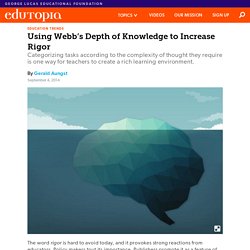
One useful tool, Norman Webb’s Depth of Knowledge Levels, can help teachers meet that challenge. Depth of Knowledge (DoK) categorizes tasks according to the complexity of thinking required to successfully complete them. Level 1. Recall and Reproduction: Tasks at this level require recall of facts or rote application of simple procedures. Level 2. Level 3. Level 4. Recently, educators have begun applying Webb’s DoK to help them design better instruction. 1. 2. 3.
The verb does not define the level. 4. 5. Apply as Needed You may be asking at this point, “Well, what is a reasonable distribution? DOK levels are not sequential. Scaffolding-critical-thinking?__sta=ns.nzl.aqj.mlzxIjlqjlbhq. Developing a lifelong learning mindset in students. During the COVID-19 pandemic, the disruption of face-to-face teaching in schools led to 1.6 billion students being forced to adapt to a more challenging alternative – remote schooling.
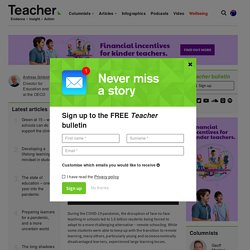
While some students were able to keep up with the transition to remote learning, many others, particularly young and socioeconomically disadvantaged learners, experienced large learning losses. A clear factor of these unequal outcomes may be the lack of digital infrastructure in disadvantaged homes or a lack of previous experience with digital tools. But inequalities in educational achievement are not only determined by economic status.
Using Success Criteria to Spark Motivation in Your Students. Think about a time when you were learning something.

Did you know where you were going in the learning progression? Did you understand the outcome? Nancy Frey, Douglas Fisher, Olivia Amador, and Joseph Assof (2018), authors of The Teacher Clarity Playbook, compare learning and outcomes to a pilot flying a plane. “Imagine getting into an airplane that was being flown by a pilot who didn’t know where he or she was headed. Rather, a control tower would contact her at some unspecified time in the future to let her know she had arrived, or worse, that she missed the mark entirely. Is Your Classroom Academically Safe?
How to Create a Self-Paced Classroom. Make It Stick: The Science of Successful Learning. How to Set Up Mastery-Based Grading in Your Classroom. 3 Steps to Successful Student Collaboration. Why We Hang In There Deep sighs, rolled eyes, slumped shoulders, and hanging heads, met with eyes yearning for hope… No, it’s not a summons for jury duty, it’s the reaction I get from teachers when I say, “student collaboration.”
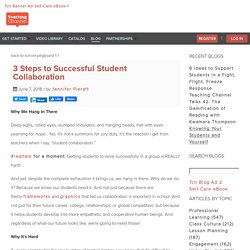
#realtalk for a moment: Getting students to work successfully in a group is REALLY hard! And yet, despite the complete exhaustion it brings us, we hang in there. 5 Ways to Help Middle and High School Students Focus on Learning Rather Than Grades. My middle and high school students eagerly walk into class with their homework fully completed, ready to ask follow-up questions.
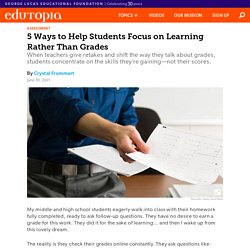
They have no desire to earn a grade for this work. They did it for the sake of learning... and then I wake up from this lovely dream. The reality is they check their grades online constantly. Amplify.
Integrating Critical Thinking Into the Classroom (Opinion) (This is the second post in a three-part series.

You can see Part One here.) The new question-of-the-week is: What is critical thinking and how can we integrate it into the classroom? Part One‘s guests were Dara Laws Savage, Patrick Brown, Meg Riordan, Ph.D., and Dr. PJ Caposey. Today, Dr. The Key to Better Student Engagement Is Letting Them Show You How They Learn. A couple of weeks ago during a coaching session, a middle school teacher I work with described a fun math activity.
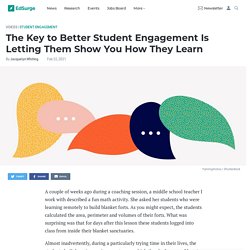
She asked her students who were learning remotely to build blanket forts. As you might expect, the students calculated the area, perimeter and volumes of their forts. What was surprising was that for days after this lesson these students logged into class from inside their blanket sanctuaries. Almost inadvertently, during a particularly trying time in their lives, the students built learning environments over which they had agency. More to the point, they were engaged. A year into the pandemic, the instructional sands keep shifting from in-person, to remote, to concurrent (or hybrid) and back again. All of them are asking, with some urgency, about how we can boost student engagement under these difficult and fluctuating circumstances. How to Teach an Inductive Learning Lesson.
A Simple Trick for Success with One-Pagers. Move Over Debate, It’s Time to Deliberate. Do you find yourself shying away from political dialogue or even avoiding it at all costs these days?

If so, you’re not alone. In fact, 53% of Americans say talking about politics with people they disagree with is “generally stressful and frustrating” (Pew Research Center, 2018). Four Research-Based Strategies Every Teacher Should be Using. 17 Ideas to Help Combat Learned Helplessness. By Sarah Tantillo Recently I’ve been thinking about the ways in which we either inculcate or prevent learned helplessness in students.

Some teaching practices help strengthen students’ self-efficacy, motivation and confidence, while others have the opposite effect. Kick the IDK Bucket: How to Rid Your Classroom of "I Don't Know" Authentic literacy - writing for a real audience. Imagine walking into your class and saying: ‘Today, you're going to write a letter ... but you're not going to send it, you'll be doing it in your school book.’
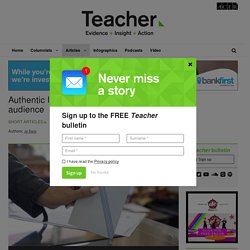
Or you could try: ‘We’re going to be working as a class to design an information leaflet for visitors to a local attraction. They won’t be used, but you can keep them once you’re finished.’ Okay, third time lucky: ‘I’d like you to work in groups to write a short story for young children, but I’ll be the only person who reads it.’ I’m exaggerating of course – you wouldn't ever say that to your students, but these rather uninspiring descriptions could be a fair reflection of how the literacy tasks work out.
Hexagonal Thinking: A Colorful Tool for Discussion. Building Study Skills: A Four-Step Plan. Study skills. They're part of the hidden curriculum, those strategies that students must learn in order to succeed. No high-stakes test I've ever seen measures "study skills" discretely. But they are the hallmark of high-achieving, confident students. Using rubrics to enhance student achievement. Almost immediately after receiving their assessment tasks back, one of my students asked, ‘Where did I lose my marks?’ While another proclaimed, ‘Why did I only get 10/20!?’ It felt as though they had completely dismissed the endless hours that went into writing individual feedback.
During my initial years of teaching, this was a common occurrence in my Year 12 Business Studies classes. Students’ questions made it apparent that they were still confused about the next steps in their learning. Results on ReadWriteThink. Grades Fail at Motivating Students. Intrinsic Motivation Works Better. We are approaching the two month mark since schools shut their doors in response to COVID-19, and we are now entering a new phase in the learning process. Despite an optimistic start, educators and students alike are realizing that remote learning is not all that it’s cracked up to be. When distance learning started it was a novelty for students; it was fun to sit at home and “go to school” without ever leaving the bed or getting out of their sweatpants.
It was funny to see the inside of a teacher’s home through their zoom screen, proving that they do actually exist outside of the classroom. That novelty has officially worn off. Zoom fatigue is real. As bad as things are, it appears that things are going to get worse before they get better. Historically, we’ve mandated students attend school, but we’ve incentivized them to do well by rewarding them with grades, GPAs and class rankings.
Six Thinking Scaffolds That Can Move Students Toward Deeper Levels of Understanding. Grotzer and a team (Nancy Oriol, Stephanie Kang, Colby Moore Reilly, and Julie Joyal) looked at the Harvard Medical School MEDscience curriculum, founded by Oriol, that uses technology-mediated, problem-based learning simulations to enrich the experience of high school biology students.
Joyal — executive director for MEDscience — and the team noticed that as their problem-based curriculum progressed, students changed the way they approached problems. Rather than waiting for the teacher to give them answers, they made hypotheses based on existing knowledge, discussed their thoughts with their teams, and took risks — all signs of deeper-level learning. Self-Paced Learning: How One Teacher Does It. How to Create Authentic Learning Provocations Students Will Love. To create provocations in learning is to open doorways for developing creativity, critical thinking, and meaningful questioning habits. When we create provocations for learners, we "provoke" and inspire the beginning of exploration. Here's a brilliant description that gets to its true essence: "Provocations can be as simple as a photo of a rock sculpture next to some pebbles or as elaborate as a table with an assortment of recycled materials next to a book on robots and resources to make up-cycled robots.
Often though, provocations are simple and displayed beautifully to provoke interest. " At one time this was called the "capture step. " Questions Students Can Ask Themselves Before, During, And After Teaching. 3 Ways to Ask Questions That Engage the Whole Class. 3 Ways to Ask Questions That Engage the Whole Class. 8 Great Strategies To Help Students Ask Great Questions - Teachthoughts.
A List of Over 100 Awesome Essential Questions Examples by Subject. 25 Powerful Creative Problem Solving Questions You Can Use for Any Challenge. 28 Question Stems That Improve Critical Thinking Ability. New Infographic: The 12 C's To Managing the Modern Classroom. Ten Creative Alternatives to Showing Movies Before the Break. 25 Self-Reflection Questions to Get Students Thinking About Their Learning. Self-reflection presents some of the most powerful instructional opportunities in our classrooms and workplaces.
Its potency is in how it exercises multiple skills. We’re talking about the skills that make our students successful, such as critical thinking, personal responsibility, useful failure, adaptability, and more. Self-reflection questions are shared in the “Debrief” stage of Solution Fluency. It’s often overlooked, which is why we made it a crucial stage in the process. When we debrief a project we reflect on everything including the process, the choices and discoveries we made, and what didn’t go quite as expected. As with any stage of using the Essential Fluencies, it comes down to asking the right self-reflection questions.
Future of Education 2030. The Millennium Project has conducted the study Education and Learning Possibilities by the Year 2030 in 2006-2007. How to Spark Curiosity in Children Through Embracing Uncertainty. In the classroom, subjects are often presented as settled and complete. Teachers lecture students on the causes of World War I, say, or the nature of matter, as if no further questioning is needed because all the answers have been found. In turn, students regurgitate what they’ve been told, confident they’ve learned all the facts and unaware of the mysteries that remain unexplored. Without insight into the holes in our knowledge, students mistakenly believe that some subjects are closed. They lose humility and curiosity in the face of this conceit. But our collective understanding of any given subject is never complete, according to Jamie Holmes, who has just written a book on the hidden benefits of uncertainty.
Watching Yourself: The Potential Of Video Recording In Student Reflection. How to Push the Boundaries of School with Dynamic Learning. John Hattie & His Top 10 High Impact Teaching Strategies. RetrievalPractice.org — Frequently Asked Questions. The Feynman Technique for learning – Food 4 Learning. Smart Strategies That Help Students Learn How to Learn. 9 Characteristics Of 21st Century Learning. 5 Ways to Teach Students to Think for Themselves. Socratic Seminars: Building a Culture of Student-Led Discussion. Preparing Students for the Computational Future. How to Teach an Inductive Learning Lesson. How can we teach kids to question? ~ A More Beautiful Question by Warren Berger. A Diagram Of 21st Century Pedagogy - How Storytelling Can Enhance Any Learning Experience.
Mix and Match Your Assessment Techniques to Boost Performance Infographic.